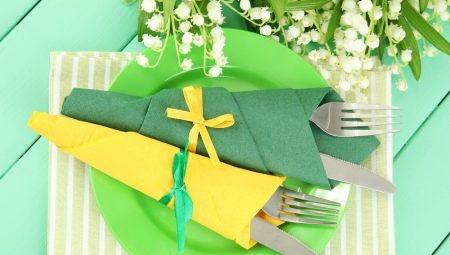Refined and stylish serving is an indispensable attribute of any feast or celebration. One of the key moments in creating an atmosphere of celebration is decorating the table with napkins. With their help, you can not only effectively decorate the table and dishes, but also set the color scheme and the mood of the event. In order to lay down simple figures, special equipment and special skills are not required. In addition, in addition to the aesthetic properties, napkins have purely utilitarian practical applications.



Features
Two types of napkins are used for serving: paper and fabric.
- Fabric products designed for individual use, they are laid out next to or on top of each guest’s plate, so that it is convenient for him to unfold and put a napkin on his lap at the beginning of the meal.
- Paper models should be arranged so that guests sitting next to them can easily reach them if necessary.
Typically, both varieties are square in shape, so the general principles of folding for them are not very different. The main difference between paper napkins is their greater fragility and smaller size, which makes it difficult to produce some particularly complex figures.

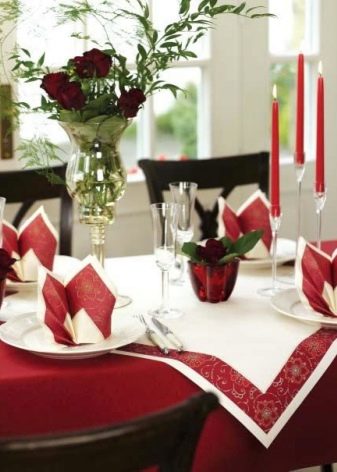
The main advantage of paper napkins is their accessibility and a wealth of colors and textures, which allows them to serve a table in any situation. Napkins can be simply laid out on napkin holders, improvised with shapes and twisted simple, cute figures, or even lay out something enchanting. The choice depends only on personal skills, wishes and preferences.
Correctly serving napkins to the table is an art that requires taking into account a number of points. The color, shape and overall creative idea should correspond to the theme and style of the event, in harmony with the tablecloth and tableware on the table. Another important point is the ease of addition.
No matter how sophisticated the form, the main task of the napkin on the table remains its direct practical purpose, so the guest should not spend much time pulling out and unfolding the napkin.
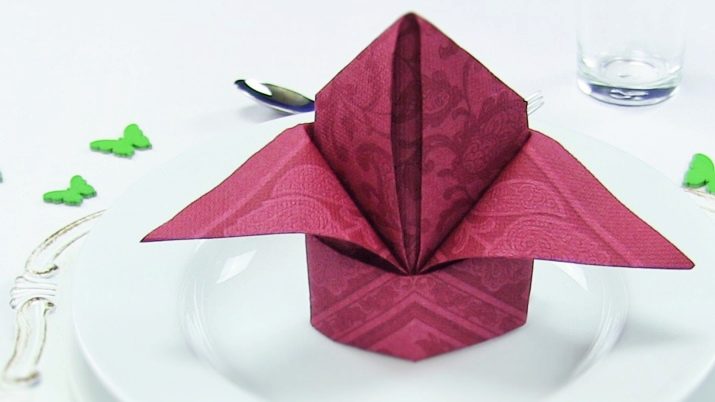

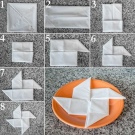



How to fold it yourself: master class
To fold paper napkins into beautiful and unusual shapes is not as difficult as it seems. Of course, as in any other business, in order to achieve mastery, it is recommended to go in stages - from a simple option to a difficult one. But the charm of origami allows even with a minimum of effort to create genuine masterpieces. Even simple children can fold simple jewelry, this process develops fine motor skills, improves intelligence and allows you to turn the chores before the arrival of guests into a real family holiday.


To make jewelry from napkins, it is best to use ready-made instructions - Schemes that describe the steps of the work step by step and various methods of folding. Often, beginners get lost, not knowing how to read such schemes, but in fact everything is quite simple: the dashed line indicates the folds, the straight line indicates the cuts, and the arrows indicate the direction of the paper fold. The semicircular arrow symbolizes a fold in the indicated direction, the zigzag arrow indicates the type of z folding, known as the accordion, and the arrow curling in the middle into a ring indicates the need to turn the product over.



There are two main ways to decorate a table with paper napkins: put on each plate an individual figure for each guest or put a few pieces in a napkin holder.
Both that and another can be issued interestingly and creatively.


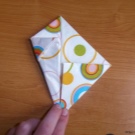
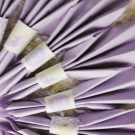

Napkin holders come in different shapes, but the main among them is the classic semicircle. However, a scattering of napkins can be put in any improvised dishes: glasses, glasses, small flowerpots or even a simple plate.
The main rule to follow is that the corners should stick out so that the products can be easily reached without destroying the entire structure.
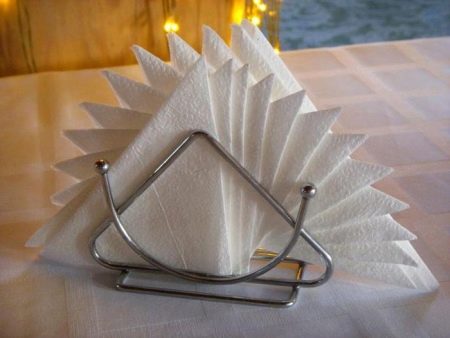
- The most common and widely known figure is single or double fan. To create it, each napkin should be bent in half to obtain a triangle, and, laying the resulting triangles on top of each other with a shift of the external angle by about one centimeter, form a fan. A single fan folds from the central triangle to the edges, and the double is formed by two rows directed towards each other. The method of folding with an “accordion” also looks interesting. The napkin is collected in an accordion with a step of one or two centimeters, is bent in half and inserted into a napkin holder.


- You can simply put a napkin in a glass using way of folding into a tube. At the same time, the napkin is folded in half, placed with the base down and neatly folded, starting from the right corner. For convenience, it is recommended that you wrap a napkin around your fingers first. The upper third is bent at the obtained tube, after which the product is placed in a glass.
- An interesting and unusual way to arrange paper napkins in a napkin holder is "bird". Opposite angles are bent several centimeters on the square napkin, after which the part is bent in half by the bent corners inward, and a trapezoid is formed. Out of several trapeziums embedded in each other and slightly extended, a bird's tail is formed. The head is made of a napkin rolled up into a tube, the tip of which is slightly bent to the side. Such a model will look especially beneficial if you use napkins of different colors for the tail.


- If you use an ordinary wide cup as a napkin holder, you can make an original and bright "Bilateral waterfall". In this case, the napkins are expanded so that a rectangle is obtained from the original square, which, depending on the size of the dishes, can be folded along one or two more times. Rectangles are stacked on top of each other, leveled and bent in the middle. The middle is recessed in the cup, after which it remains only to straighten the hanging sheets. Origami figures mounted on a plate can be divided into two types. The figures directly relate to one - flowers, animals, leaves, the other type combines pockets-napkins in which you can wrap or put cutlery, fresh flowers or branches.


- Napkins are very popular among children and youth. in the form of rabbits. The napkin is double folded in half with the edges up, resulting in a long narrow strip. The edges of the strip are grasped and simultaneously bent down so that an angle forms at the upper midpoint of the strip. The next step, one after another, the lower edges are bent to the center, and then also fold in half, forming ears. Then the central upper triangle bends backward, and one of the ears is tucked into the pocket of the other, after which it remains only to turn over and smooth the rabbit.

- Another interesting way is fanning. The napkin unfolds and folds in half so that the front side is outside. Further, about three quarters of the length, a not very large accordion is made. The next step, the origami is bent in half, the tail not folded in accordion is bent inward, and the figure is set on the surface.
- To make the envelope, it is advisable to take larger and denser wipes. The napkin is laid with a rhombus so that the angle with single layers looks to the right, then double-bends in half and bends back to a rhombus. After that, the uppermost layer of the napkin is taken on the right and bent in half three times so that as a result it passes through the middle line of the figure. The next layer is bent twice in a similar way, reaching the midline, after which the figure turns inside out and rotates to a square. The sides of the square are bent to the middle, the figure is turned over for the last time by the other side, and an envelope with two pockets is formed.

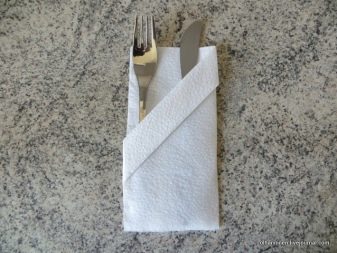
Tips & Tricks
Table decor experts believe that the color scheme and the method of folding napkins should correspond to the theme of the event. And if for a friendly party or a feast in a narrow circle it is enough to just submit paper napkins in a napkin holder or a glass, then you should set the table for a festive event and receive guests with more refined figures.
An important point is the color scheme:
- For a children's holiday or a youth party, bright plain napkins or products decorated with an interesting gradient, a fun print or pattern will become a good option.
- The family celebration will be decorated with restrained pastel and beige tones.
- At a formal event, it is preferable to choose plain models or napkins with a minimal strict print.



Thematic colors do not lose relevance. On New Year's Eve, red-green and burgundy-gold colors look win-win, traditional spring colors are shades of pink, light green and blue, and autumn is associated with purplish, sunny yellow and a touch of ocher. For a romantic dinner, it is better to stay in classic white, red and pink colors. However, atypical combinations can be the highlight of the evening, the main thing is not to overdo the experiments.



It is better to fold the napkins in advance, because, despite the apparent simplicity, it takes quite a lot of time.
You should practice in advance and twist a few napkins the day before in order to remember the folding methods and the features of creating the form. In an extreme case, if it was not possible to practice, the planned form does not work out or there simply is not enough time, the easiest way is to lay napkins in a stack on a plate.
For greater aesthetics, each subsequent product can be stacked with a slight shift.so that as a result a multi-pointed asterisk is formed.
Such an easy and elegant way will not only help out in difficult times, but will also look quite worthy, not inferior to sophisticated serving options.



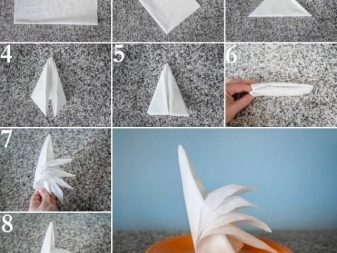
Beautiful examples and options
Despite the fact that there are a number of traditional schemes and options that are customary to use for table setting, you can add almost any shape from a huge arsenal of origami if you want and with proper preparation of paper napkins. Of course, you will have to invest a lot of time and effort, because such work can only be done by a person who already has experience in creating origami.





For example, from light yellow and green napkins you can fold a whole lotus. This design option looks bright and atypical. Due to the high cost of material and painstaking work, it hardly makes sense to put such a figure on the plate of each guest. Such a form implies a purely decorative, rather than practical application. We decorate the table with several lotuses that will guarantee an unforgettable evening.



A more modest, but no less difficult from the technical side, option is to make a complex rose, for example, Kawasaki roses. Under the flower is laid several green leaves collected by a simple method of zigzag crease. Depending on the situation, the rose itself can be of different colors, but it is better to give preference to natural colors: white, cream, pink, red.

Other natural origami options will also look original.
With the help of several napkins, you can build an elegant butterfly, which makes sense to decorate with a small bow or other small ornaments.

Combinations of paper leaves, for example, a mini-bouquet fastened in the middle by a ring or ribbon, also look win-win. Its lower half is compressed, forming a cylinder - a trunk, and carved leaves fluff up at the top. A combination of three corrugated sheets fastened in the lower quarter with an elastic band and decorative adornment is simple in execution. An interesting combination of colors will give a special charm to such a composition.

Even the idea of serving a napkin in a napkin holder can be approached very creatively - to use as a napkin holder not even the cup itself, but its handle. A napkin stuck in the hole is not only easily inserted and removed, but also gives the feast a festive atmosphere due to the contrasting color and unusual shape.


You will learn more about how to fold paper napkins for the festive table in the next video.
